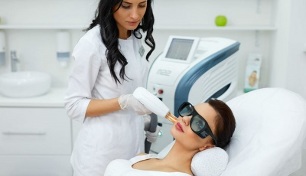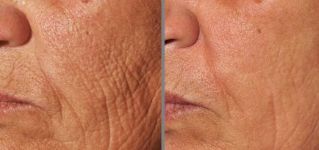
Fractional facial rejuvenation is a laser procedure used for various skin problems. Perfectly removes hyperpigmentation, acne scars, wrinkles, leaving the face young and fresh.
Due to its effectiveness, this cosmetic method is very popular among clinic patients.
How does fractional facial rejuvenation differ from laser resurfacing and other procedures
Fractional rejuvenation uses non-ablative lasers that do not cause strong heating and do not damage the skin. The laser beam passes through the fractional grating and splits into many small "beams" that heat the target tissue and do not destroy it. The energy from the laser creates hot little "bumps" on the skin that stimulate the growth of new, healthy cells to replace old damaged ones.
The increase in temperature stimulates the production of collagen protein at the points of laser penetration. This triggers the rejuvenation process that is carried out from the inside, affecting all the structures of the skin. A mild effect and little trauma is especially important in facial rejuvenation, because the skin here is especially thin and vulnerable.
After the course of the procedures, the face looks more beautiful and younger. Wrinkles, age spots, laxity, acne scars, large pores and other blemishes disappear. Since during fractional rejuvenation, there is a point effect and the device controls the depth of penetration of the beam, the skin is less damaged than with grinding or chemical peels.
The laser is so gentle that most patients do it without anesthesia. For added convenience, a cooling element is integrated directly into the handpiece of the device. In case of hypersensitivity, an anesthetic gel is used.
Since the laser used for fractional resurfacing is gentle on the skin, several treatments are required to achieve the desired results. The resulting effect is not inferior to other more traumatic anti-aging methods.
Indications and contraindications for fractional facial rejuvenation
- Age-related changes: The procedure improves the complexion. Signs of aging are eliminated: fine lines, wrinkles, spots caused by lipofuscin pigment deposition.
- Acne scars (post-acne): When treating acne scars, the procedure works more effectively than creams, masks, serums and other external agents. The laser beam penetrates the skin to a depth of 1mm and destroys the scar tissue. No cosmetic preparation can do this.
- Post-operative and traumatic scars: The laser removes or leaves less visible traces of operations, medical procedures, injuries and burns.
- Pigmented spots: With fractional facial rejuvenation, accumulations of pigment caused by aging processes, sun exposure, hormonal increases during pregnancy and medications are destroyed. During the course of the procedures, the dark lesions on the face gradually lighten and disappear.
Due to its gentle action, the procedure has a minimum of contraindications. These are purulent skin lesions, herpes, a pronounced inflammatory process, malignant tumors, open wounds and abrasions, pregnancy. It is not recommended to do a fractional rejuvenation at a high temperature and feel bad.
Preparation for procedure and fractional facial rejuvenation
One week before the first laser session, you should stop using cosmetics with retinoids, derived from vitamin A. These substances increase the photosensitivity of the skin and can cause the appearance of age spots.
Before the procedure, the specialist treats the skin with products that cleanse the skin of the face and improve the penetration of the laser beam. The eyes are protected with special glasses. The laser is aimed at an area where there are skin problems: uneven texture, increased pigmentation, wrinkles and other blemishes.
After that, a rejuvenation session is performed, the duration of which is 20 to 50 minutes. The doctor makes sure that all necessary areas are treated with care. Exposure to the laser is not accompanied by pain and discomfort. You only feel warmth and a slight tingling sensation, which do not create discomfort. After the procedure is finished, you can leave the clinic immediately.
What happens after fractional facial rejuvenation?
After the procedure, there may be slight redness and swelling of the face, but the skin will not be very red and scaly. In a couple of days everything disappears.
To achieve the full result, it is recommended to perform 3-5 sessions with an interval of 2-6 weeks. So, the results of laser resurfacing will not be inferior to the effect obtained after mechanical resurfacing and other cosmetic methods.

The effect is not immediately visible and depends on the existing problems. Pigmented spots are cleared up in one or two sessions, scars and wrinkles can be removed in 3-5 visits to the clinic. After the course of the procedures is over, the skin condition will improve for another six to eight weeks.
For the first week after the procedure, a mild, moisturizing cleanser should be applied to the skin twice a day. This will help prevent flaking and irritation of the skin. Washing with ice water gives a good effect. Useful intake of ascorbic acid - vitamin C.
After laser exposure, you need to protect your skin from UV rays, so apply a moisturizing sunscreen for a month. You cannot sunbathe and use the solarium.
It is forbidden to apply preparations on the face that are not recommended by a cosmetologist. This can lead to age spots, irritation, peeling, and infection.
Fractional facial rejuvenation gives good results lasting up to two years. To maintain the effect, you need to use care agents and regularly perform other cosmetic procedures that delay aging.





















